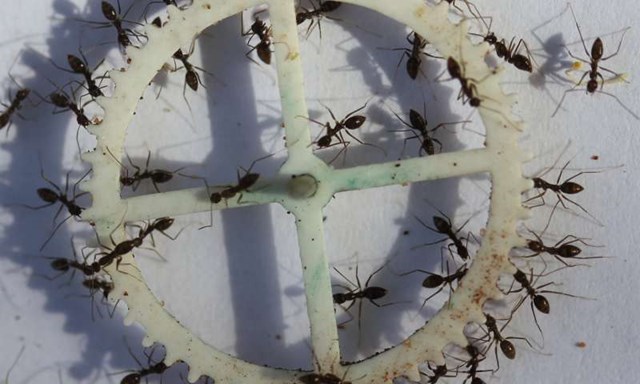
A top view of the ants carrying the cargo item (wheel-like object). Credit: Jonathan Ron, Ehud Fonio
Ants working together to carry a large piece of food get around obstacles by switching between two types of motion: one that favors squeezing the morsel through a hole and another to seek a path around the barrier. Jonathan Ron of the Weizmann Institute, Israel, and colleagues present these findings in PLOS Computational Biology.
When carrying large food items such as worms or maggots, ants often face obstacles in their path. The cooperating ants need to reach a consensus and decide on a new route to their nest. Previous studies have shown that alternating, side-to-side motions can help ants get around an obstacle, but what drives this motion and determines whether it will happen has been unclear.
Ron and colleagues built a mathematical model that simulates ants' behavior when facing a rigid barrier with a narrow hole. The simulations suggest that ants randomly switch between two modes of motion, one in which they dwell near the hole, providing a chance to pass food through it, and another in which sideways motions allow them to seek their way around the obstacle. Switching between modes ensures the ants do not get stuck in a single mode without finding a solution.
The model also predicts that the size of the food-carrying ant group, which reflects the size of the food item, determines which mode of motion will dominate. Small groups with smaller items will spend more time near the hole, while larger groups perform more sideways motions to get around the barrier. When encountering the obstacle each ant continues to behave according to the rules that govern their free, unhindered motion. Nevertheless, when encountering the obstacle these same rules give rise to the coexistence of the two observed motions that allow them to overcome the obstacle. In other words, the problem is "solved" by the collective without any of the individuals realizing the exact nature of the problem.
Study co-author Ofer Feinerman then led the testing of these model predictions in experiments with real ants carrying cargo that ranged from 1 cm to 4 cm in diameter. When the ants encountered a rigid barrier with a narrow hole, they did indeed switch between the two types of motion predicted by the model. Smaller groups carrying smaller items spent more time near the hole, as predicted.
"Many social animals—from bird flocks to schools of fish to troops of baboons—perform cooperative tasks, such as foraging, hunting, and migrating," says study senior author Nir Gov. "Our results could provide inspiration for similar understanding of other collective animal behavior systems that exhibit coexisting modes."
Next, the research team plans to investigate the motion of food-carrying ants through complex terrain with many obstacles of varying sizes and shapes, as found in natural conditions.
